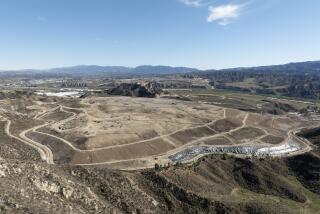Proposed Community Near Grand Canyon Stirs Debate : Development: Backers say the plan could reduce crowding. Critics see it as another tourist attraction.
- Share via
FLAGSTAFF, Ariz. — A proposal to build a planned community seven miles from the rosy-brown South Rim of the Grand Canyon has prompted concerns about additional environmental damage in an area that is already heavily congested.
At issue is Canyon Forest Village, proposed for 725 acres about 2 1/2 miles south of the park’s South Rim entrance. It would include private housing, rental units, mobile homes, hiking and biking trails, an “experiential education center,” as well as a retail center, schools and churches.
Developers say the project will help reduce park overcrowding. Scottsdale, Ariz.-based Canyon Forest Village Corp. and its attorney, former Arizona Gov. Bruce Babbitt, claim the subdivision and its adjacent facilities might even set the example for other national parks to reverse a trend of overcrowding and commercialism, returning to the public the more natural park system of a half century ago.
But environmentalists worry the development could pull even more tourists to the Grand Canyon, a symbol of the threatened environment and already heavily impacted by visitors and their vehicles. They also argue that the question of water availability must be addressed before any ground is broken.
According to park figures, more than 4 million people visited the Grand Canyon last year. This figure is expected to double by the end of this century.
Backers of the proposed development claim that tourist and automobile congestion already ruins the park experience for Grand Canyon visitors.
“The South Rim has been the victim of zero planning,” argued Babbitt, a 1988 Democratic presidential candidate and now national president of the League of Conservation Voters. “It’s the strangest place in the West. You’ve got thousands of miles of open space and your first view of the Grand Canyon is from 10 acres of asphalt. And then you have Grand Canyon Village, which on a summer day is gridlocked from dawn to dusk. It’s a mess.”
One environmentalist voiced skepticism that the proposed project would eliminate the mess.
“The experiential center. Right. Formerly known as Disneyland,” fumed Rob Smith, Southwest representative of the Sierra Club. “They’re trying to sell you that it’s not a convention center, it’s a nature center. It still looks like a tourist attraction to me in a place that hardly needs another.”
If the Forest Service approves the land exchange, the Kaibab National Forest would obtain about 1,500 acres of current private holdings--fingers of private land extending into public lands--and the developers would acquire about 725 acres of what is now public land south of Tusayan, Ariz.
Environmentalists in Arizona have urged caution regarding the land exchange but do not reject it. Five environmental groups detailed their position in a letter to the Kaibab National Forest supervisor and the Grand Canyon National Park superintendent.
“Our groups would oppose a Tusayan land exchange that proposes major developments that could become attractions in and of themselves,” read the Sept. 1 letter from representatives of Grand Canyon Trust, The Wilderness Society, Sierra Club, National Parks and Conservation Assn. and Northern Arizona Audubon Society. But the coalition said it would support an exchange that would improve “the efficiency and effectiveness of public transportation into Grand Canyon National Park and that helps remedy existing needs” of the park. They said the Park Service needs to address overall developments in and around the park.
Grand Canyon National Park officials agree.
“We do need to look beyond our park boundaries,” said John Reed, assistant park superintendent. “But what people have to realize is that our ability to make things happens stops at the South Entrance or Desert View entrance as far as actually taking action and incurring federal costs.”
Babbitt argued that the land swap could be the catalyst for such orchestration.
“This land exchange can be the magnet that draws it all together,” he said.
An environmentally sensitive development, proponents say, could allow employees to live outside of the park and also could be a staging area for tourists, who could leave their autos behind and go into the park by bus.
More to Read
Sign up for Essential California
The most important California stories and recommendations in your inbox every morning.
You may occasionally receive promotional content from the Los Angeles Times.













